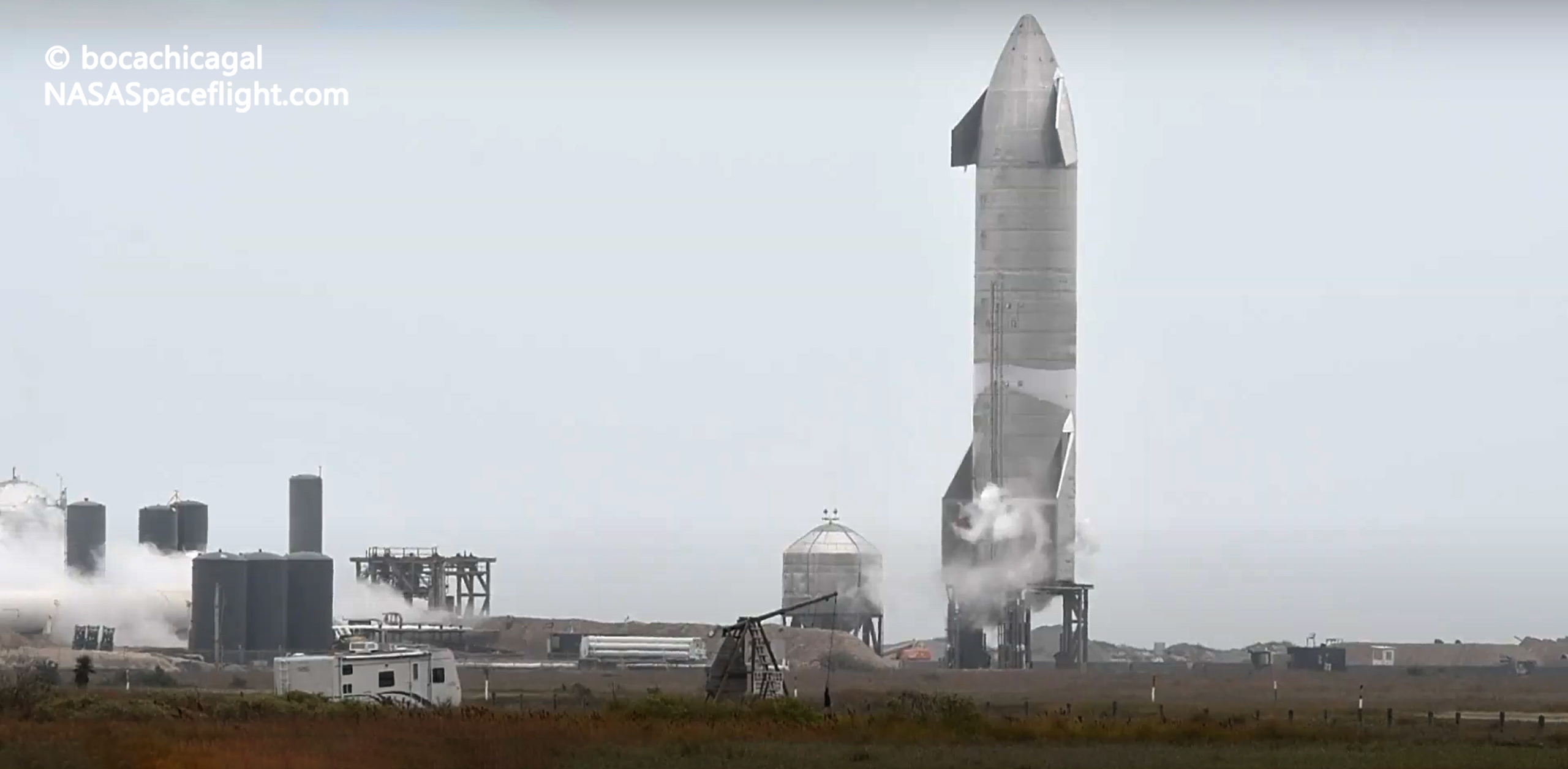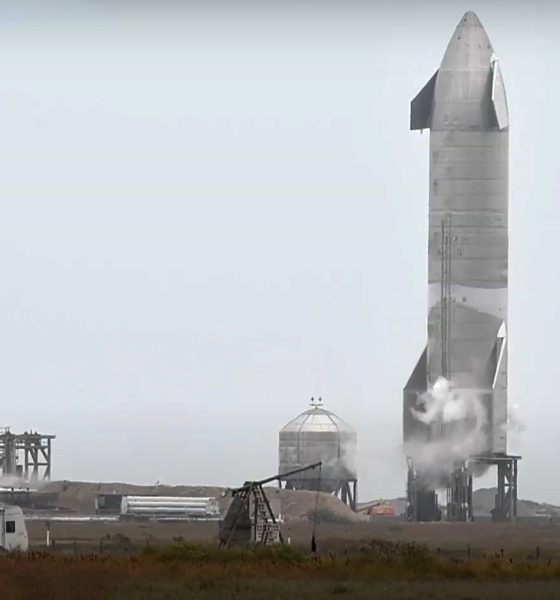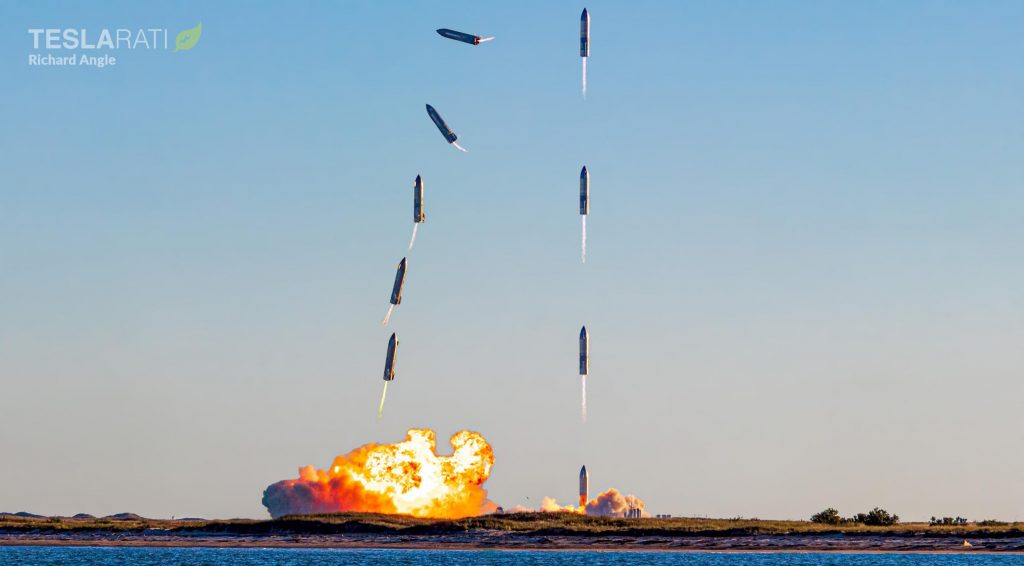

News
SpaceX aborts several Starship static fire attempts, rolls test tank to the pad
Accidentally producing the polar opposite of Starship serial number 9 (SN9) completing a trio of Raptor ignition tests in four hours last week, SpaceX has now suffered three back-to-back static fire aborts on January 20th.
On January 13th, Starship SN9 somewhat successfully ignited its Raptor engines three separate times with zero hands-on human intervention or inspection. While an impressive feat, SpaceX CEO Elon Musk soon revealed that two of the rocket’s three engines were damaged during the test campaign. NASASpaceflight.com later reported that the company had detected an issue with one Raptor after the first three-engine static fire, ultimately firewalling it and performing the next two static fires with only two engines.
SpaceX initially allotted five days to replace the two damaged Raptors (SN44 & SN46), scheduling road closures (a telltale sign of test plans) on January 18th, 19th, and 20th. Windows on the 18th and 19th went by with zero attempts. Finally, on the 20th, SpaceX kicked off Starship SN9’s first real test attempt since the engine swap around 2pm but it was aborted by 3pm.
After an extremely brisk recycle, Starship likely made it less than a minute away from ignition but the second attempt was ultimately aborted around 3:40 pm.
Two hours later, after SpaceX extended the end of its road closure from 5pm to 8pm, Starship SN9’s third Raptor static fire attempt was also aborted – once again just a minute or less away from ignition.
SpaceX held Starship SN9 for another hour or so after the third abort but ultimately began final detanking and depressurization around 6:50 pm, marking the end of the day’s attempts.
It’s impossible to say what caused Wednesday’s back-to-back-to-back aborts or if the three instances were connected. While potentially frustrating to watch from the sidelines, it’s crucial to remember that the public is getting a truly unprecedented continuous view of SpaceX’s process of developing and refining a world-class launch vehicle. Additionally, every abort Starship suffers should theoretically produce volumes of valuable data that both Starship and Raptor teams can use to better understand how to design, build, test, and operate the cutting-edge vehicle and its engines.
More likely than not, SpaceX is leaning towards caution (and thus cautious hardware and software limits) while attempting to prepare Starship SN9 for its true data-gathering purpose – an SN8-style high-altitude launch and landing attempt.

SpaceX is currently scheduled to try again with another series of Starship SN9 static fire attempts between 8am and 5pm CST (UTC-6) on Thursday, January 21st.
Meanwhile, prior to SN9’s multiple Wednesday aborts, SpaceX rolled the latest in a series of Starship ‘test tanks’ from the factory to the launch pad. A team rapidly strapped the tank to the concrete pad and connected it to ground support equipment in preparation for a series of tests that will likely end with SpaceX intentionally pressurizing the tank until its bursts. If successful, it will open the door for future Starships to save weight by cutting steel skin thickness from 4mm to 3mm.
Stay tuned for updates on both active test campaigns.

News
Elon Musk’s Grokipedia surges to 5.6M articles, almost 79% of English Wikipedia
The explosive growth marks a major milestone for the AI-powered online encyclopedia, which was launched by Elon Musk’s xAI just months ago.

Elon Musk’s Grokipedia has grown to an impressive 5,615,201 articles as of today, closing in on 79% of the English Wikipedia’s current total of 7,119,376 articles.
The explosive growth marks a major milestone for the AI-powered online encyclopedia, which was launched by Elon Musk’s xAI just months ago. Needless to say, it would only be a matter of time before Grokipedia exceeds English Wikipedia in sheer volume.
Grokipedia’s rapid growth
xAI’s vision for Grokipedia emphasizes neutrality, while Grok’s reasoning capabilities allow for fast drafting and fact-checking. When Elon Musk announced the initiative in late September 2025, he noted that Grokipedia would be an improvement to Wikipedia because it would be designed to avoid bias.
At the time, Musk noted that Grokipedia “is a necessary step towards the xAI goal of understanding the Universe.”
Grokipedia was launched in late October, and while xAI was careful to list it only as Version 0.1 at the time, the online encyclopedia immediately earned praise. Wikipedia co-founder Larry Sanger highlighted the project’s innovative approach, noting how it leverages AI to fill knowledge gaps and enable rapid updates. Netizens also observed how Grokipedia tends to present articles in a more objective manner compared to Wikipedia, which is edited by humans.
Elon Musk’s ambitious plans
With 5,615,201 total articles, Grokipedia has now grown to almost 79% of English Wikipedia’s article base. This is incredibly quick, though Grokipedia remains text-only for now. xAI, for its part, has now updated the online encyclopedia’s iteration to v0.2.
Elon Musk has shared bold ideas for Grokipedia, including sending a record of the entire knowledge base to space as part of xAI’s mission to preserve and expand human understanding. At some point, Musk stated that Grokipedia will be renamed to Encyclopedia Galactica, and it will be sent to the cosmos.
“When Grokipedia is good enough (long way to go), we will change the name to Encyclopedia Galactica. It will be an open source distillation of all knowledge, including audio, images and video. Join xAI to help build the sci-fi version of the Library of Alexandria!” Musk wrote, adding in a later post that “Copies will be etched in stone and sent to the Moon, Mars and beyond. This time, it will not be lost.”
News
Tesla Model 3 becomes Netherlands’ best-selling used EV in 2025
More than one in ten second-hand electric cars sold in the country last year was a Tesla Model 3.

The Tesla Model 3 became the most popular used electric car in the Netherlands in 2025, cementing its dominance well beyond the country’s new-car market.
After years at the top of Dutch EV sales charts, the Model 3 now leads the country’s second-hand EV market by a wide margin, as record used-car purchases pushed electric vehicles further into the mainstream.
Model 3 takes a commanding lead
The Netherlands recorded more than 2.1 million used car sales last year, the highest level on record. Of those, roughly 4.8%, or about 102,000 vehicles, were electric. Within that growing segment, the Tesla Model 3 stood far ahead of its competitors.
In 2025 alone, 11,338 used Model 3s changed hands, giving the car an 11.1% share of the country’s entire used EV market. That means more than one in ten second-hand electric cars sold in the country last year was a Tesla Model 3, Auto Week Netherlands reported. The scale of its lead is striking: the gap between the Model 3 and the second-place finisher, the Volkswagen ID3, is more than 6,700 vehicles.
Rivals trail as residual values shape rankings
The Volkswagen ID.3 ranked a distant second, with 4,595 used units sold and a 4.5% market share. Close behind was the Audi e-tron, which placed third with 4,236 registrations. As noted by Auto Week Netherlands, relatively low residual values likely boosted the e-tron’s appeal in the used market, despite its higher original price.
Other strong performers included the Kia Niro, the Tesla Model Y, and the Hyundai Kona, highlighting continued demand for compact and midsize electric vehicles with proven range and reliability. No other model, however, came close to matching the Model 3’s scale or market presence.
News
Tesla Model Y Standard Long Range RWD launches in Europe
The update was announced by Tesla Europe & Middle East in a post on its official social media account on X.

Tesla has expanded the Model Y lineup in Europe with the introduction of the Standard Long Range RWD variant, which offers an impressive 657 km of WLTP range.
The update was announced by Tesla Europe & Middle East in a post on its official social media account on X.
Model Y Standard Long Range RWD Details
Tesla Europe & Middle East highlighted some of the Model Y Standard Long Range RWD’s most notable specs, from its 657 km of WLTP range to its 2,118 liters of cargo volume. More importantly, Tesla also noted that the newly released variant only consumes 12.7 kWh per 100 km, making it the most efficient Model Y to date.
The Model Y Standard provides a lower entry point for consumers who wish to enter the Tesla ecosystem at the lowest possible price. While the Model 3 Standard is still more affordable, some consumers might prefer the Model Y Standard due to its larger size and crossover form factor. The fact that the Model Y Standard is equipped with Tesla’s AI4 computer also makes it ready for FSD’s eventual rollout to the region.
Top Gear’s Model Y Standard review
Top Gear‘s recent review of the Tesla Model Y Standard highlighted some of the vehicle’s most notable features, such as its impressive real-world range, stellar infotainment system, and spacious interior. As per the publication, the Model Y Standard still retains a lot of what makes Tesla’s vehicles well-rounded, even if it’s been equipped with a simplified interior.
Top Gear compared the Model Y Standard to its rivals in the same segment. “The introduction of the Standard trim brings the Model Y in line with the entry price of most of its closest competition. In fact, it’s actually cheaper than a Peugeot e-3008 and costs £5k less than an entry-level Audi Q4 e-tron. It also makes the Ford Mustang Mach-E look a little short with its higher entry price and worse range,” the publication wrote.








